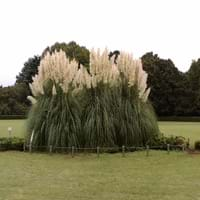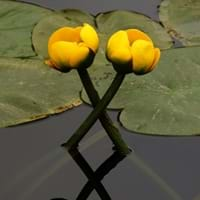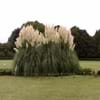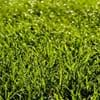Life Span
Annual or Biennial
Perennial
Origin
South America, Micronesia, New Zealand
North America
Types
Silver pampas grass, Uruguayan pampas grass, Purple pampas grass
not available
Habitat
Lawn
canals, Lakes, marshes, Ponds, sloughs, sluggish streams and rivers, springs
USDA Hardiness Zone
7-11
3-12
AHS Heat Zone
11 - 7
12-1
Sunset Zone
H1, 3a, 3b, 4, 5, 6, 7, 8, 9, 10, 11, 12, 13, 14, 15, 16, 17, 18, 19, 20, 21, 22, 23, 24
21,22
Habit
Clump-Forming
Clump-Forming
Minimum Width
Not Available
Flower Color
Pink, Violet, White hair and some brown spots on margins and at tips
Yellow
Flower Color Modifier
Bicolor
Not Available
Fruit Color
Not Available
Non Fruiting Plant
Leaf Color in Spring
Green, Light Green, Dark Green
Green, Dark Green
Leaf Color in Summer
Light Green
Green, Dark Green
Leaf Color in Fall
Green, Light Green, Dark Green
Green, Dark Green
Leaf Color in Winter
Dark Green, Tan
Not Available
Leaf Shape
Long and slender with very sharp edges
Heart-shaped
Plant Season
Spring, Summer, Fall, Winter
Spring, Summer, Fall
Sunlight
Full Sun
Full Sun, Partial Sun
Type of Soil
Loam
Clay, Loam, Sand
The pH of Soil
Acidic, Neutral
Acidic, Neutral, Alkaline
Soil Drainage
Well drained
Poorly Drained
Bloom Time
Summer, Fall
Summer, Late Summer
Tolerances
Drought, Salt
Wet Site
Where to Plant?
Ground
In Water
How to Plant?
Seedlings, Stem Planting
Seedlings
Plant Maintenance
Low
Medium
Watering Requirements
Average Water Needs, Needs watering once a week, Reduce water once established, Water more frequently during periods of extreme drought
Plant grows in water
In Summer
Lots of watering
Aquatic Plant
In Spring
Moderate
Aquatic Plant
In Winter
Average Water
Aquatic Plant
Soil pH
Acidic, Neutral
Acidic, Neutral, Alkaline
Soil Type
Loam
Clay, Loam, Sand
Soil Drainage Capacity
Well drained
Poorly Drained
Sun Exposure
Full Sun
Full Sun, Partial Sun
Pruning
Prune in late winter, Remove branches, Remove damaged leaves, Remove dead branches, Remove dead leaves, Remove deadheads
No pruning needed
Fertilizers
Apply 10-10-10 amount, Nitrogen, Phosphorous, Potassium
Not Available
Pests and Diseases
Red blotch
Aphids, Beetles, China Mark Moth, Leaf Rollers, Leeches, Lily Leaf Spot, Mosquito, Muck Midge, Ostracods, Snails, Spider mites, Tadpoles, Whiteflies
Plant Tolerance
Drought, Salt
Wet Site
Flower Petal Number
Single
Single
Foliage Texture
Fine
Coarse
Foliage Sheen
Matte
Glossy
Invasive
Sometimes
Sometimes
Attracts
Birds, Rats, Snakes
Not Available
Allergy
Itchiness, Skin cuts
Not Available
Aesthetic Uses
Showy Purposes
Showy Purposes
Beauty Benefits
Not Available
Not Available
Edible Uses
Insignificant
Yes
Environmental Uses
Air purification, Provides ground cover
Ethnobotanic, Wildlife
Medicinal Uses
Not Available
Anaphrodisiac, Anodyne, Antiscrophulatic, Antispasmodic, Astringent, Cardiotonic, Demulcent, Hypotensive, Sedative, Vasoconstrictor
Part of Plant Used
Flowers, Leaves
Flowers, Root
Other Uses
Fibre, Food for animals, Used in paper industry
Used As Food, Used as Ornamental plant
Used As Indoor Plant
Insignificant
No
Used As Outdoor Plant
Yes
Yes
Garden Design
Dried Flower / Everlasting, Cutflower, Dried Flower/Everlasting, Feature Plant, Foundation, Groundcover, Mixed Border, Screening / Wind Break
Water Gardens
Botanical Name
CORTADERIA
NUPHAR lutea
Common Name
Pampas Grass
Common Spatterdock, Yellow Pond Lily
In Hindi
Pampas grass
पीला तालाब लिली
In German
Pampasgrass
Gelbe Teichrose
In French
herbe de la pampa
Jaune nénuphar
In Spanish
cortaderas
Lirio amarillo estanque
In Greek
γρασίδι Πάμπα
Κίτρινο λίμνη κρίνος
In Portuguese
grama de Pampas
Lagoa do lírio amarelo
In Polish
Pampas trawy
Żółty staw lilii
In Latin
Pampas herba
Yellow piscinam lilium
Phylum
Vascular plant
Magnoliophyta
Class
Liliopsida
Liliopsida
Family
Poaceae
Nymphaeaceae
Clade
Angiosperms, Commelinids, Monocots
Angiosperms
Tribe
Danthonieae
Not Available
Subfamily
Danthonioideae
Not Available
Number of Species
Not Available
Importance of Pampas Grass and Yellow Pond Lily
Want to have the most appropriate plant for your garden? You might want to know the importance of Pampas Grass and Yellow Pond Lily. Basically, these two plants vary in many aspects. Compare Pampas Grass and Yellow Pond Lily as they differ in many characteristics such as their life, care, benefits, facts, etc. Every gardener must at least have the slightest clue about the plants he wants to plant in his garden. Compare their benefits, which differ in many ways like facts and uses. The medicinal use of Pampas Grass is Not Available whereas of Yellow Pond Lily is Anaphrodisiac, Anodyne, Antiscrophulatic, Antispasmodic, Astringent, Cardiotonic, Demulcent, Hypotensive, Sedative and Vasoconstrictor. Pampas Grass has beauty benefits as follows: Not Available while Yellow Pond Lily has beauty benefits as follows: Not Available.
Compare Facts of Pampas Grass vs Yellow Pond Lily
How to choose the best garden plant for your garden depending upon its facts? Here garden plant comparison will help you to solve this query. Compare the facts of Pampas Grass vs Yellow Pond Lily and know which one to choose. As garden plants have benefits and other uses, allergy is also a major drawback of plants for some people. Allergic reactions of Pampas Grass are Itchiness and Skin cuts whereas of Yellow Pond Lily have Not Available respectively. Having a fruit bearing plant in your garden can be a plus point of your garden. Pampas Grass has showy fruits and Yellow Pond Lily has no showy fruits. Also Pampas Grass is flowering and Yellow Pond Lily is not flowering . You can compare Pampas Grass and Yellow Pond Lily facts and facts of other plants too.





